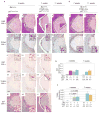Skp2 is required for survival of aberrantly proliferating Rb1-deficient cells and for tumorigenesis in Rb1+/- mice
- PMID: 19966802
- PMCID: PMC2990528
- DOI: 10.1038/ng.498
Skp2 is required for survival of aberrantly proliferating Rb1-deficient cells and for tumorigenesis in Rb1+/- mice
Abstract
Heterozygosity of the retinoblastoma gene Rb1 elicits tumorigenesis in susceptible tissues following spontaneous loss of the remaining functional allele. Inactivation of previously studied retinoblastoma protein (pRb) targets partially inhibited tumorigenesis in Rb1(+/-) mice. Here we report that inactivation of pRb target Skp2 (refs. 7,8) completely prevents spontaneous tumorigenesis in Rb1(+/-) mice. Targeted Rb1 deletion in melanotrophs ablates the entire pituitary intermediate lobe when Skp2 is inactivated. Skp2 inactivation does not inhibit aberrant proliferation of Rb1-deleted melanotrophs but induces their apoptotic death. Eliminating p27 phosphorylation on T187 in p27T187A knock-in mice reproduces the effects of Skp2 knockout, identifying p27 ubiquitination by SCF(Skp2) ubiquitin ligase as the underlying mechanism for Skp2's essential tumorigenic role in this setting. RB1-deficient human retinoblastoma cells also undergo apoptosis after Skp2 knockdown; and ectopic expression of p27, especially the p27T187A mutant, induces apoptosis. These results reveal that Skp2 becomes an essential survival gene when susceptible cells incur Rb1 deficiency.
Conflict of interest statement
Figures





References
-
- Yamasaki L, et al. Loss of E2F-1 reduces tumorigenesis and extends the lifespan of Rb1(+/-)mice. Nat Genet. 1998;18:360–364. - PubMed
-
- Lee EY, et al. E2F4 loss suppresses tumorigenesis in Rb mutant mice. Cancer Cell. 2002;2:463–472. - PubMed
-
- Takahashi C, et al. Nras loss induces metastatic conversion of Rb1-deficient neuroendocrine thyroid tumor. Nat Genet. 2006;38:118–123. - PubMed
Publication types
MeSH terms
Substances
Grants and funding
LinkOut - more resources
Full Text Sources
Other Literature Sources
Molecular Biology Databases
Miscellaneous

